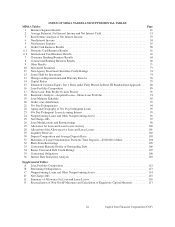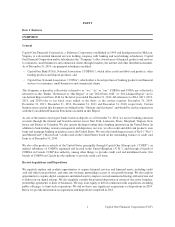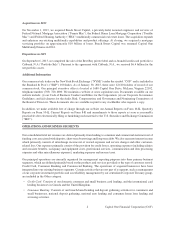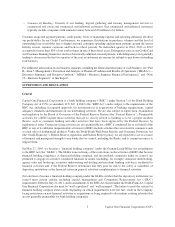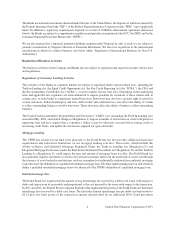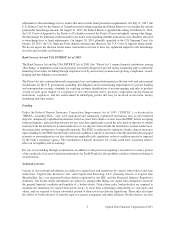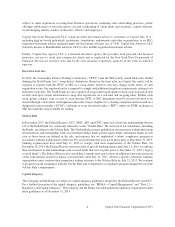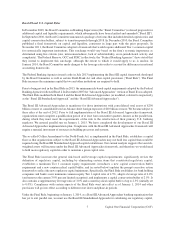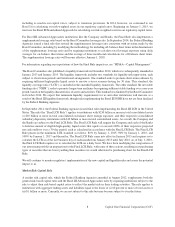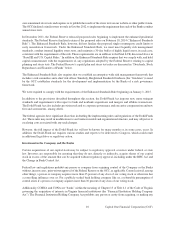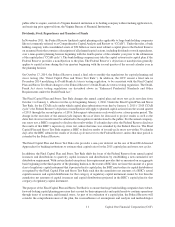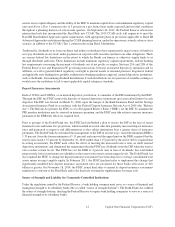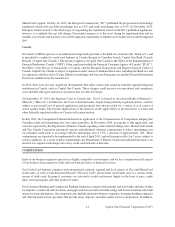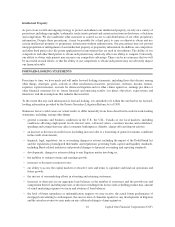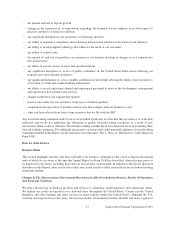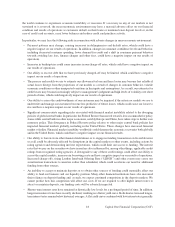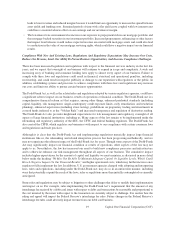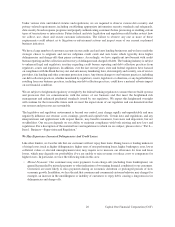Capital One 2014 Annual Report Download - page 32
Download and view the complete annual report
Please find page 32 of the 2014 Capital One annual report below. You can navigate through the pages in the report by either clicking on the pages listed below, or by using the keyword search tool below to find specific information within the annual report.own semiannual stress tests and requires us to publish the results of the stress tests on our website or other public forum.
The OCC finalized a similar stress test rule in October 2012, to implement the requirement that each of the Banks conduct
annual stress tests.
In December 2011, the Federal Reserve released proposed rules beginning to implement the enhanced prudential
standards. The Federal Reserve finalized certain of the proposed rules on February 18, 2014 (“Enhanced Standards
Rule”). The Enhanced Standards Rule, however, did not finalize the proposed single-counterparty credit limits or
early remediation framework. Under the Enhanced Standards Rule, we must meet liquidity risk management
standards, conduct internal liquidity stress tests, and maintain a 30-day buffer of highly liquid assets, in each case,
consistent with the requirements of the rule. These requirements are in addition to the Final LCR, discussed above in
“Basel III and U.S. Capital Rules.” In addition, the Enhanced Standards Rule requires that we comply with, and hold
capital commensurate with the requirements of, any regulations adopted by the Federal Reserve relating to capital
planning and stress tests. The Federal Reserve’s capital plan and stress test rules are discussed in “Dividends, Stock
Repurchases and Transfers of Funds” below.
The Enhanced Standards Rule also requires that we establish an enterprise-wide risk management framework that
includes a risk committee and a chief risk officer. Similarly, Heightened Standards Guidance (the “Guidance”) issued
by the OCC establishes standards for the development and implementation by the Banks of a risk governance
framework.
We were required to comply with the requirements of the Enhanced Standards Rule beginning on January 1, 2015.
In addition to the provisions described throughout this section, the Dodd-Frank Act imposes new, more stringent
standards and requirements with respect to bank and nonbank acquisitions and mergers and affiliate transactions.
The Dodd-Frank Act also includes provisions related to corporate governance and executive compensation and new
fees and assessments, among others.
The federal agencies have significant discretion in drafting the implementing rules and regulations of the Dodd-Frank
Act. These rules may result in modifications to our business models and organizational structure, and may subject us to
escalating costs associated with any such changes.
However, the full impact of the Dodd-Frank Act will not be known for many months or, in some cases, years. In
addition, the Dodd-Frank Act requires various studies and reports to be delivered to Congress, which could result
in additional legislative or regulatory action.
Investment in the Company and the Banks
Certain acquisitions of our capital stock may be subject to regulatory approval or notice under federal or state
law. Investors are responsible for ensuring that they do not, directly or indirectly, acquire shares of our capital
stock in excess of the amount that can be acquired without regulatory approval, including under the BHC Act and
the Change in Bank Control Act.
Federal law and regulations prohibit any person or company from acquiring control of the Company or the Banks
without, in most cases, prior written approval of the Federal Reserve or the OCC, as applicable. Control exists if, among
other things, a person or company acquires more than 25 percent of any class of our voting stock or otherwise has
a controlling influence over us. For a publicly traded bank holding company like us, a rebuttable presumption of
control arises if a person or company acquires more than 10 percent of any class of our voting stock.
Additionally, COBNA and CONA are “banks” within the meaning of Chapter 13 of Title 6.1 of the Code of Virginia
governing the acquisition of interests in Virginia financial institutions (the “Financial Institution Holding Company
Act”). The Financial Institution Holding Company Act prohibits any person or entity from acquiring, or making any
10 Capital One Financial Corporation (COF)


